She has been coined by many as “the first female serial killer in the United States.” A title she may not deserve, but her wickedness definitely cannot be argued.
Lavinia and her husband John Fisher lived in Charleston, South Carolina. Together they owned and operated an inn, the Six Mile Wayfarer House. Back in the early 1800s inns were placed outside of towns and were like “rest stops” for folks that had been traveling. They were a place to water and feed your horse, have a bite to eat, and perhaps a bed to sleep in for the night, before completing your journey. There may have been some gambling that would take place inside the inns, as well as some other “extra-curricular” activities, but all in the name of early capitalism. And their names were less than creative since they served as mile markers into the town or city, they were called, Six Mile House, Five Mile House, Four Mile House…
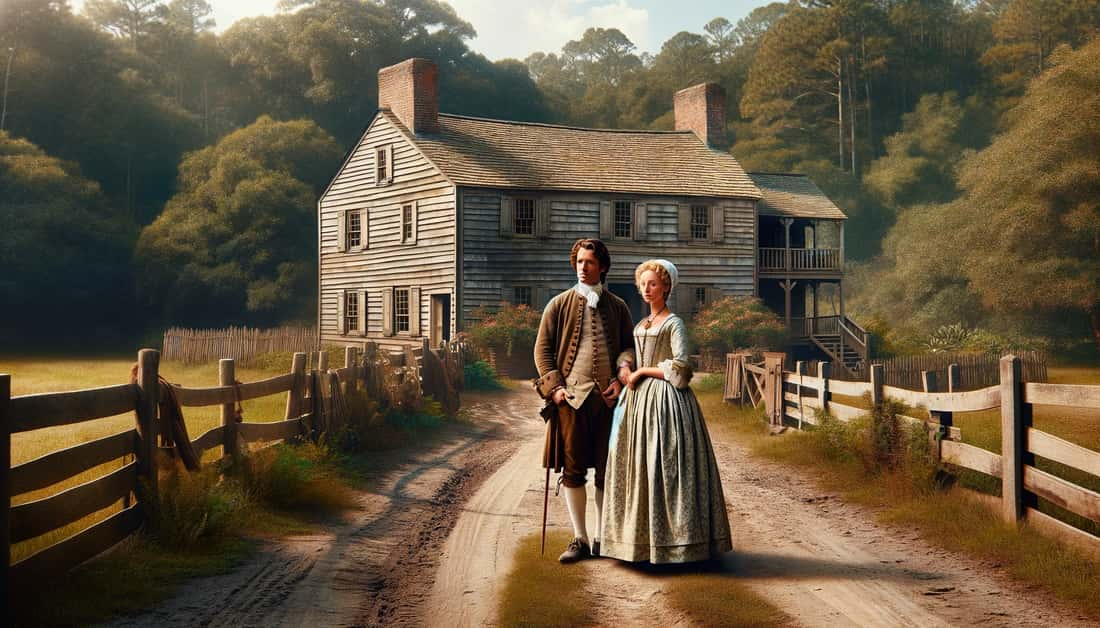
Rumors and concerns began to generate around the Charleston community and reports were made to the local sheriff that people had started to disappear after visiting the Six Mile House. There wasn’t much evidence to substantiate these reports and because John and Lavinia were attractive and a well-liked couple, nothing ever came of the concerns. But eventually, some of Charleston’s vigilantes decided to take the investigation into their own hands.
The country was young in 1819. We were dealing with pirates and privateers on our seas and in our port cities, and for many who made their living on land, it was in trades, and everything was fair game for trade: people, livestock, harvest or whatever else they had that others wanted. These were America’s first entrepreneurs, the early days of a hustle.
Driving your wagon into town with the hopes of selling your goods wasn’t always a simple or safe process. Full wagons were often hijacked by highwaymen as they approached the town and robbed of the goods they were trading, or they may be ambushed on their way out of town and robbed of the money they had just made selling their goods. Charleston was a major port city, which brought in plenty of traders, and kept the highwaymen busy.
The stories began when unsuspecting men were lured into a few of the inns to join in poker games, only to then be cheated out of their money by crooked gambling practices and scams. In addition to the complaints made by the men who had just lost their earnings in what they thought were gentlemen’s gambles, a man named Stephen Lacoste, reported that his cow had been stolen out of his pasture. It seemed these highwaymen had moved on from their hijacking and gambling, and onto outright thievery of locals.
The citizens of Charleston decided they’d had enough. They were not going to let these bandits cause more problems for their city’s already struggling economy. They set out on February 16, 1819, a well-armed organized mob operating under “Lynch's Law” taking matters into their own hands. Their destination was Five Mile House.
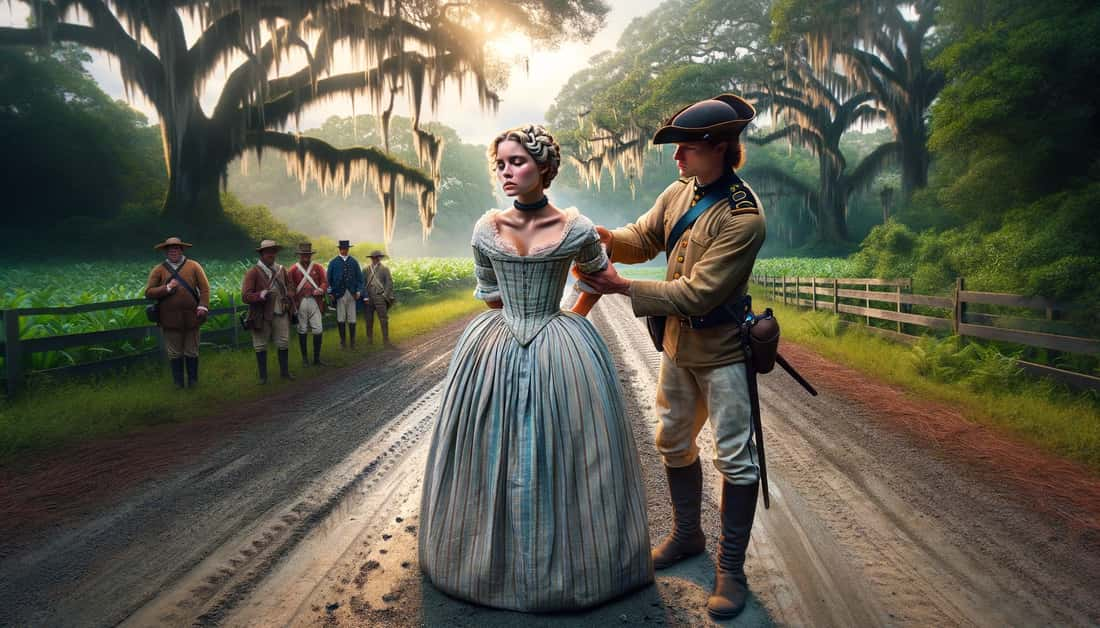
There is something delightfully intriguing about a female criminal. Some would say that’s a sexist statement, but one has to admit that the idea of a woman choosing to kill is creepy. Lavinia Fisher was said to be an attractive young woman, beguiling to some, which definitely ups the creep factor. But a killer? That’s questionable.
The Lynch Mob had arrived at Five Mile House and ordered the small group inside to vacate. The group protested, and the Lynch Mod set the building on fire. It didn’t take long for the Five Mile House to burn to the ground, which set the Mob’s adrenalin racing. Next, they were onto the Six Mile Wayfarer House to complete their mission of homegrown justice.
The Mob barreled into the Six Mile House and gave the same orders, “you have fifteen minutes to vacate or we set the House on fire.” The occupants of the Six Mile House complied, probably because they had smelled the smoke and heard the hubbub that came up from the Five Mile House moments earlier. Once all had left the premises, the Mob placed David Ross inside the house to watch over the property.
The Lynch Mob returned to Charleston feeling proud that they had successfully served their own brand of justice. Even the local newspaper, The Charleston Courier, reported their success on Saturday, February 20, 1819. But poor David Ross must not have realized that being the Six Mile House “watchman” was quickly going to turn into a precarious and dangerous position.
As Mr. Ross stood watched, the occupants who had been driven out of the Six Mile House returned, and they were angry. They violently attacked Mr. Ross, but somehow he managed to escape into the woods and get back to Charleston. When he arrived, he gave a sworn affidavit to the authorities on the events that happened at Six Mile House.
William Hayward came to Six Mile House of which he was in possession, accompanied by another person, whose name is unknown by him, that the said Hayward cursed him, collared him violently, and pushed him out of doors.
Mr. Ross claims he stepped up to Hayward and his partner, demanding to return inside to fetch the things that belonged to him. According to his affidavit, the altercation continued and became more violent:
Hayward put his hand into his bosom, and said you damned infernal rascal, if you lay your hand on anything, I will blow your brains out.
And now enters our dastardly lady of the hour, Lavinia Fisher and her husband, John.
Fisher and his wife Lavinia Fisher came up, with two other men, whose names are unknown to him - that Lavinia Fisher laid violent hands upon him, choaked [sic] and boxed his head through a pian [sic] of window glass - whilst I was endeavoring to get away from them, Hayward and Fisher beat him unmercifully, with loaded whips aided and assisted by the other two men, whose names are unknown to him, there was also another woman, who aided an assisted, whilst they were beating him, the deponent leapt out of the piazza, and crossed the road through the woods then he got to the Four Mile House, but just as he had entered the woods, they fired at him, he got at least into the main road and on his way to town.
Apparently, Mr. Ross was incredibly agile to escape such an overpowering and violent crew. When he made it back to Charleston he recalled hearing Fisher scream, “ you damned infernal rascal if I ever catch you, I will give you a hundred lashes!” “Infernal rascal,” Hollywood couldn’t write that jewel.
Two hours later another man, John Peeples, who was watering his horses at the Six Mile House also claims to have been attacked and robbed. He, too, gave a sworn affidavit alleging that Lavinia and John Fisher were a part of the gang that so cruelly beat him and threatened his life.
Now the law steps in.
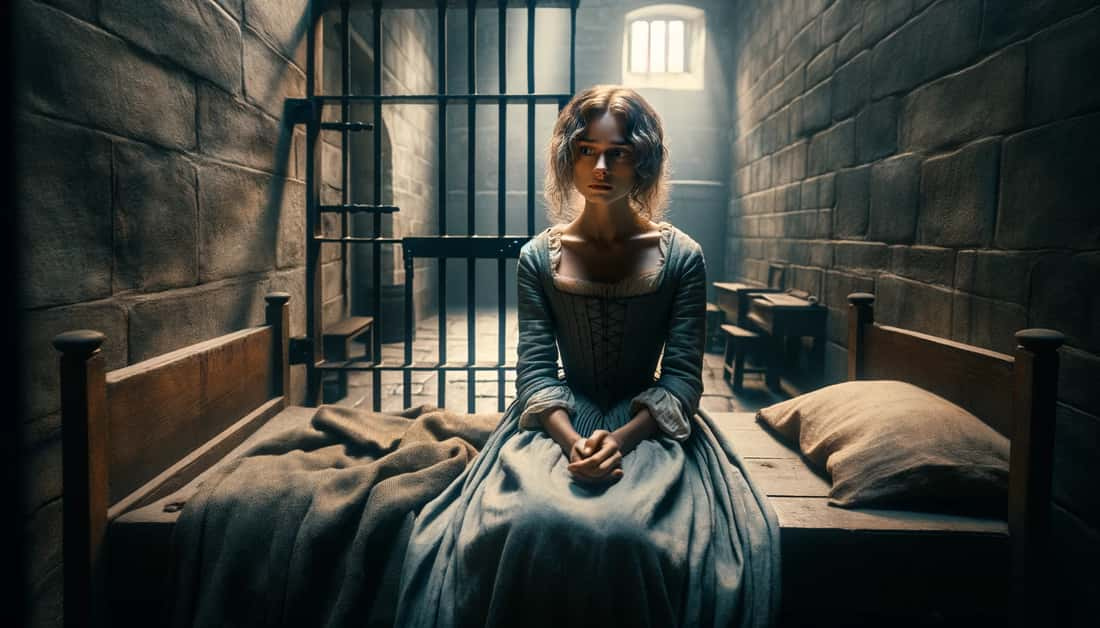
Two victims, who are also eyewitnesses, and their affidavits were what was needed to get the Sherrif involved. Sherrif Nathanial Greene Cleary gathered a party of men and set out for the Six Mile Wayfarer House. They surrounded the property, locked and loaded, and were prepared for a fight. But without any drama, the gang of criminals surrendered. Some stories say that John didn’t want to put his wife, Lavinia, in harm's way, and that’s why he surrendered without resistance.
John and Lavinia Fisher, James McElroy, Seth Young, and Jane Howard were taken into custody and loaded into a paddy wagon for their six-mile ride straight to the City Jail on Charleston’s Magazine Street. Some of the sheriff’s posse stayed behind to go through the contents of the house and the outbuildings, where they found the hide of a freshly slaughtered cow. They immediately speculated that this was the cow that had reportedly gone missing a few days earlier.
Once the sweep of the insides had been completed, Six Mile House and the outbuildings were set fire and burnt to the ground. Leaving nothing behind of the supposed rest stop of horrors but ash and embers.
Whilst in the City Jail, John and Lavinia tried to escape, but the plan was foiled when the rope that carried John down from the window broke and left Lavinia stranded. John wouldn’t leave Lavinia. They were taken back into custody and held with much tighter security. One wonders if Lavinia would have done the same for John.
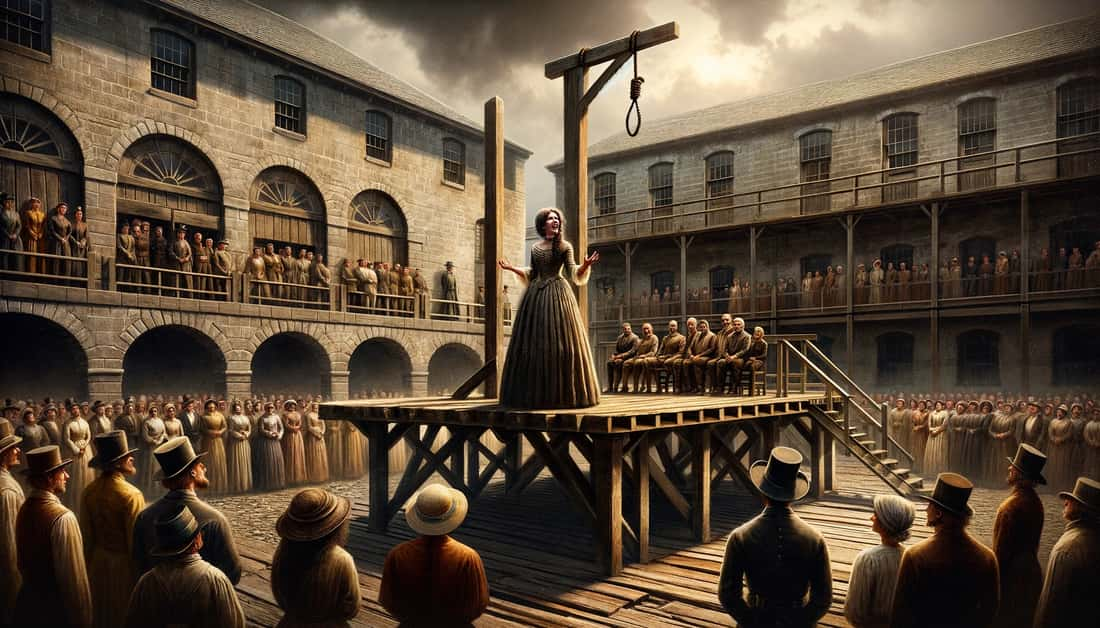
John and Lavinia Fisher appeared before the constitutional court on January 17, 1820. It was reported in the Charleston Courier that they were convicted of highway robbery and condemned to be hanged on Friday, February 4, 1820. It appears that the original charges of assault with the intent to murder were off the table. Now, John and Lavinia were going to hang for the robbery upon John Peeples, the second victim who gave the affidavit to authorities. It’s a bit confusing on why John and Lavinia Fisher were convicted of a crime against Mr. Ross, but sentenced to death for a crime against Mr. Peeples, which they were never convicted of, but it seems the system wasn’t always in favor of due process in the early 19th century.
Governor Geddes received a wealth of pleas from John and Lavinia Fisher, local clergy, and respectable citizens asking for a time of respite from the February 4th execution day, for John and Lavinia to “prepare to meet their God.” The Governor granted the requests and reset their execution date for February 18, 1820. Lavinia believed that the additional two weeks granted would ensure her a pardon, and her declares of innocence would be all she needed to set her free.
In their last two weeks behind the walls of the City Jail, John and Lavinia spent time with Reverend Dr. Richard Furman. The Reverend had a Baptist ministry and a significant influence in the development of the Baptist denomination. The Reverend was determined to prepare the Fisher’s souls for the afterlife. The preparation was received welcomingly by John, but Lavinia Fisher didn’t have the patience for prayer. She was consumed with professing her innocence and not believing that her Governor would hang a woman.
When February 18th arrived, a coach awaited the Fishers and their executioner to deliver them to the gallows. The Fishers walked arm in arm from the prison door to the coach and began their procession to their fate. A large crowd had gathered, the Fishers had become celebrities in Charleston, and Lavinia was being made an example of as the first woman sentenced to hang in the Holy City.
It is documented that upon the Fishers arrival, John Fisher turned pale and his body began to tremor uncontrollably while inside of the carriage. He grabbed for Lavinia and pulled her close to him. Seconds later, the Fishers and their executioner exited the carriage.
John bravely climbed the scaffolds. Lavinia refused. Constables were forced to drag her, as she screamed for the crowd to rescue her, imploring for their pity and professing her innocence. As the clock was ticking on the gallows, Lavinia’s desperation turned to profanity and curses. She damned the Governor to hell and stomped her feet.
John lovingly pleaded with Lavinia. He tenderly asked her to make peace with God. She refused, only to speak the words that are, to this day, repeated as part of the Lavinia Fisher story:
Cease! I will have none of it. Save your words for others that want them. But if you have a message you want sent to Hell, give it to me; I’ll carry it.
Twenty-nine-year-old John Fisher and twenty-eight-year-old Lavinia Fisher were hanged at 2:00pm on February 18, 1820. The Charleston Courier reported on February 19, 1820, that the couple embraced as the signal was given and the drop fell. Lavinia died almost immediately, but it took a few minutes for John to expire. Their bodies were taken down from their ropes and buried at Potter’s Field.
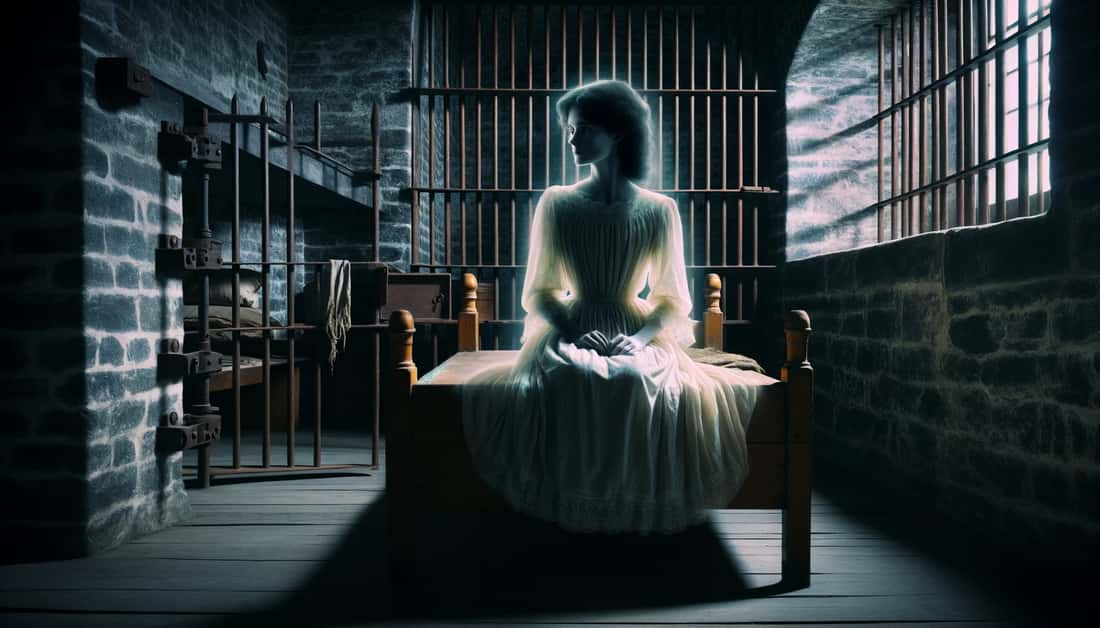
Lavinia is a favorite on ghost tours. Many say that she still haunts the Old City Jail, and others claim she haunts the Unitarian Cemetery. Which is odd, considering she was never buried in the Unitarian Cemetery. But they’re “ghost stories…”
Paranormal experts would say that because she was filled with so much anger and defiance when she was executed, it would be expected that her spirit never found peace. This may cause her to roam and haunt the last areas she knew and where she felt the most unsettled in life. Places like the Old City Jail and where the gallows once stood.
There’s something else just as disturbing as her questionable sentence and town hanging, something even more macabre than the ghost of an alleged criminal, it’s gawking at her bones. The Yorkville Enquirer posted proudly on August 8, 1922, “Skeleton on Display.” The article goes on to explain Lavinia Fisher’s skeleton was exhibited at the Charleston museum “some time ago” and was “removed because it was out of order, the museum has decided again to install them, and it is now being put in order.”
The Yorkville Enquirer continues to write about the infamous Lavinia and John Fisher and what they were hanged for, “considerable curiosity was aroused over the continued disappearances of those who stopped overnight at the hostelry… it was found that the guests had been murdered and their bones buried in the cellar.” You can’t help but wonder if Lavinia’s story grew into such a tall tale immediately after she saw her unjust demise on the gallows, or if it took a few decades to grow.
Perhaps her ghost does roam the downtown streets of Charleston. Angry and bitter at her mistreatment and her life cut short. Or maybe she’s just looking for her bones.
Take a tour in Charleston, and you will undoubtedly hear a version of the Lavinia Fisher story. The most popular one talks about her nefarious ways of luring travelers into the Six Mile Wayfarer House for a lovely dinner and conversation, only to then send them off to bed with a cup of her oleander poisoned tea. As the male travelers fell into a deep sleep, she would steal their money and belongings, as her husband would ensure their death by stabbing them.
Another juicy Lavinia Fisher story introduces a mysterious trap door into her arsenal of murder tactics. As the lone traveler lie asleep from her specially blended tea, Lavinia would pull a lever that opened a trap door in the floor. The bed would collapse and drop the poor sleepy victim into a pit in the basement of the house. Many like to add to the embellishment saying that there were spikes at the bottom of the pit, which impaled the victims as they landed.
There isn’t any proof of either of these stories. Bruce Orr has done extensive research for his book (Go Buy It!), Six Miles to Charleston: The True Story of John and Lavinia Fisher, and if any of those stories had merits of truth, he would have found them. He does, however, reveal Charleston’s dark history and paints an image of the Holy City that doesn’t seem so “holy.” These sordid tales of Lavinia Fisher aren’t always accurately delivered, and after a lot of historical excavation, it could be that John and Lavinia Fisher weren’t as bad as modern storytellers portray them to be. Greedy and unscrupulous? Sure. Murderers? Not proven. But Lavinia and John are commonly portrayed as 19th century’s Bonnie and Clyde.
The story of Lavinia Fisher is just one of the amazing histories that you'll hear about on our Charleston Ghost Tours. Ghost City Tours has been Charleston's favorite Ghost Tour company for over 10 years. We'd love to share more of haunted Charleston with you!